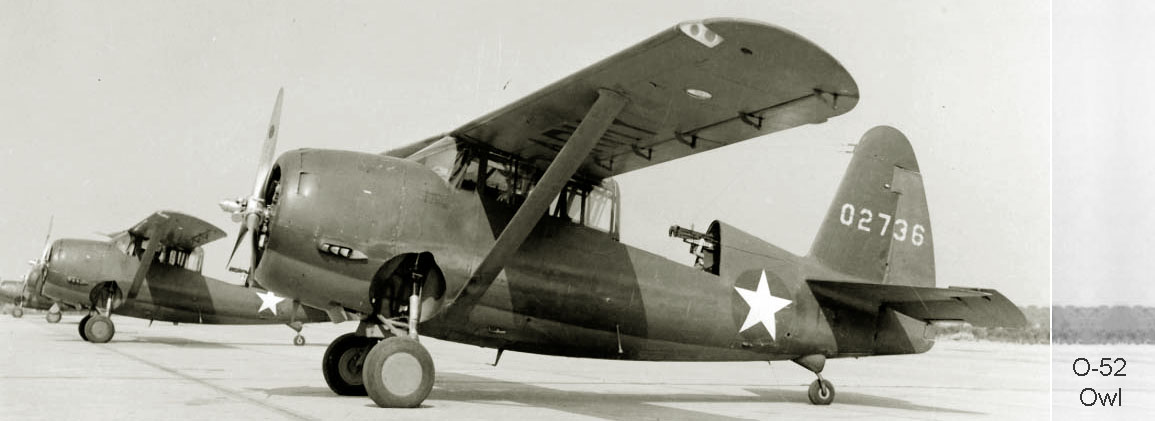
Aviation of World War II


 |
Aviation of World War II |


|
|
Soviet Union | Lend - Lease | Facts | Forum | Germany | Japan | R A F | U S A A F | Other | Photos |
|
|
O-52 "Owl"Army Scout ObserverCurtiss
The designers focused on takeoff and landing qualities, maneuverability, reliability and low cost of the design. They chose for their aircraft a strut-braced high-wing scheme, previously tested on the experienced carrier-based fighters XF12C-1 and XF13C-1. This scheme provided excellent visibility to both crew members - the pilot and the observer pilot, who were seated in a common closed spacious cockpit. The result is a light and compact aircraft of a somewhat peculiar appearance - a short barrel-shaped fuselage and a long straight wing, reinforced by struts going to the fuselage. To achieve good takeoff and landing qualities, the wing was equipped with slats and flaps. Hover-type ailerons were also included in the scheme of its mechanization: when the flaps were extended to the maximum angle, both ailerons also went down and deflected by 15 °. Both the slats and the flaps were hydraulically controlled. The O-52 turned out to be lighter than all the machines of a similar class that were in service with the European army - the English Westland Lisander, the German Henshel Hs 126B and our P-10. The light weight was partly due to the abandonment of the secondary role of the direct support aircraft. O-52, unlike other close scouts, could not carry a bomb load. Armament was limited to two 7.62 mm Colt Browning machine guns. One of them, synchronous, stood motionless in front (with 200 rounds of ammunition), and the second (with 500 rounds) - on the pivot mount behind the place of the letnab, who also served as a shooter. In the stowed position, the installation was covered with a gargrot, which dropped down when firing. At the same time, the lantern over the place of the letnab moved forward. The plane had no armor protection. The US Army Air Corps ordered a series of 203 aircraft even before the first flight of the prototype, which took to the skies in 1941, followed immediately by production vehicles. The O-52 turned out to be maneuverable, pleasant to fly and quite fast. The combination of light weight and good aerodynamics made the O-52, with its 600-horsepower engine, not inferior in speed to the O-47A with an engine of 975 hp. However, the practice of hostilities in Europe has shown that the very idea of a classic close-range reconnaissance is already outdated. He was unable to operate in conditions of powerful air defense, a large concentration of enemy fighters in the air. Slow and lightly armed "universal" biplanes and monoplanes began to be replaced by high-speed machines, usually converted from fighters. Brief Technical DescriptionThe close scout O-52 "Oul" was an all-metal strut-braced high-wing aircraft with a straight wing of high aspect ratio. Tricycle chassis with a tail wheel. The main struts were retracted into the fuselage, as on the RF2C-1 deck bomber (but with a hydraulic drive, not a manual winch). The narrow track of the landing gear was certainly a disadvantage for the aircraft, which was to operate on primitive forward airfields. But the upper position of the wing eliminated the danger of catching on the ground with extreme rolls on landing. The tail wheel was not retracted. Power plant - Pratt & Whitney R-1340-51 Wasp air-cooled piston 9-cylinder radial engine, 600 hp, (450 kW) rotated a three-bladed Hamilton Standard automatic propeller. The fuel, with a total volume of 408 liters, was in two unprotected tanks in the wing. The crew of two was housed in a closed cockpit. The aircraft was controlled in two ways - in the cockpit of the letnab, it was planned to install a removable control stick and folding pedals were installed. The equipment consisted of a landing light, a radio station, an SPU, a radio semi-compass. The installation of the camera was provided. |
|
Lend - Lease Lend-Lease | A 20 | B 17 | B 25C | B 25J | Mitchell in USSR | P 39 | P 40 | P 47 | P 63 | Hurricane Mk.2 | Hurricane in USSR | Spitfire Mk.5 | Spitfire Mk.9 | O-52 | PBN-1 | |